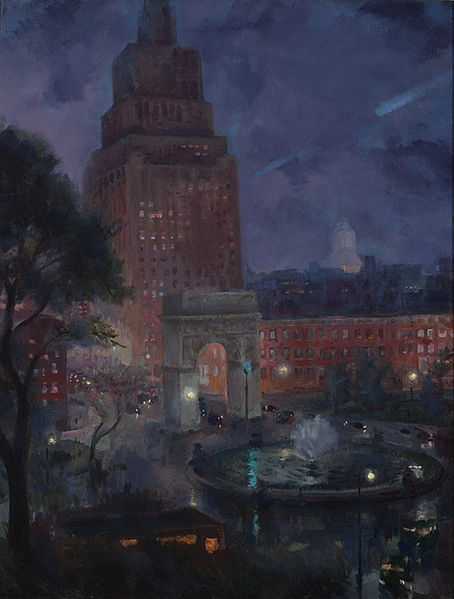Historical Development / Urban Planning
16
May 11
NYU and the Battle for Land in the Village
Although it is a thriving institution of Greenwich Village, New York University (NYU) has consistently found itself at odds with Village residents. Since NYU announced its plans in April 2010 to expand its campus by over six million feet by 2031, residents have organized through local government, public rallies, and community organizations to protest the growth of the university, in an attempt to preserve the aesthetic character of their neighborhood.
16
May 11
Envisioning Modern Urbanity: John Sloan’s Images of Greenwich Village 1900-1930
“Some people have expressed themselves as discouraged in their expectation of finding any art in America, and have ‘long since ceased to hope!’ Let us remember that art…has always existed, in all nations, and the tradition will probably not die here.” – Robert Henri (Sloan’s mentor)

McSorley’s Bar (1912) by John Sloan, oil on canvas, 66.04 x 81.28 cm, Detroit Institute of the Arts
Painted in 1912, this painting depicts a day-time scene in McSorely’s, a popular drinking establishment near Cooper Union that was popular with working class Irish men. Sloan chose to do sketches of the bar at the insistence of Henri, who suggested that the bar was the epitome of the masculine ideal necessary for good painting. The painting shows five men standing at the bar, drinking and talking. McSorely’s was known as a place for philosophizing working people. The painting is done in this impressionistic style but unlike true impressionism, this painting feels more solid. The unifying element of the image is the solidity of the bar counter and all of the men in the painting holding onto it and, in the case of the men talking at the right, almost drawing life and motion from it. In a world of chaos and social change, Sloan paints a dying breed of old Irish-immigrant worker in Greenwich Village as at once fleeting and solid. His characters appear almost heroic.
John Sloan lived in Greenwich Village at the historical turning point when the Village of immigrants became the Bohemian Village. He saw all of this unfolding before him and recorded it in painting. His works are an expression of the passage of time and timeless human qualities of the urban landscape .Sloan’s paintings show a neighborhood in upheaval and constant change typical of the modern period. Staying away from the flat, propagandist style of other socialist-inspired artists and writers and far away from the Arcadian visions of the academic art, Sloan’s multifaceted, often humorous Village genre scenes are indicative of a neighborhood’s complex responses to the social and cultural changes wrought by industrial capitalism in the early-twentieth century. Sloan, unlike many contemporary American artists, found beauty and delight in the working class scenes he saw on the streets of Greenwich Village. To him, these little Greenwich Village scenes were slices of a grand modern epic–the transition into modernity.

Wet Night, Washington Square, 1928, John Sloan (1871–1951) Oil on panel, 26 x 20 inches, Delaware Art Museum
What would be peaceful night on the park is wired with the energy of passing cars and electric lights.
-Daniel Solecki
dsolecki@hunter.cuny.edu
16
May 11
Cultural Significance of the Greenwich Mews

Image from Wikimedia Commons
The Mews are an entire street of converted stables, just above Washington Square North.
16
May 11
Cherry Lane Theatre: 1996-2010
From it’s foundation as a non- profit venture in 1996 through the announcement of its closing in 2010, Cherry Lane Theatre flourished and became much more than New York’s longest running off- Broadway playhouse under new artistic director and co- founder Angelina Fiordellisi. With numerous impressive new programs, Cherry Lane successfully fostered the growth of new playwrights and reignited itself as an integral part of the Greenwich Village Community. Cherry Lane Theatre serves as an experimental lab for the development of new American works and a home for groundbreaking productions of both new and classic theater of the highest caliber.
In December of 2010, Fiordellisi announced her resignation. Cherry Lane Theatre is now for sale. Fiordellisi said, “I feel that we can no longer do theater for the sake of the art form. We have to adhere to the formula of having a film star in our productions to sell tickets because it’s so financially prohibitive. I don’t want to do theater like that.” It is true that small companies and off- Broadway houses are finding it increasingly difficult to compete with the pizazz and allure of Broadway spectaculars, especially as they implement more technological nuances to captivate audiences in this age of technology. It is uncertain what the future holds for Cherry Lane Theatre. This year, companies such as Barefoot Theatre Company are utilizing the stages, but there have been no public developments in the sale of the playhouse.
